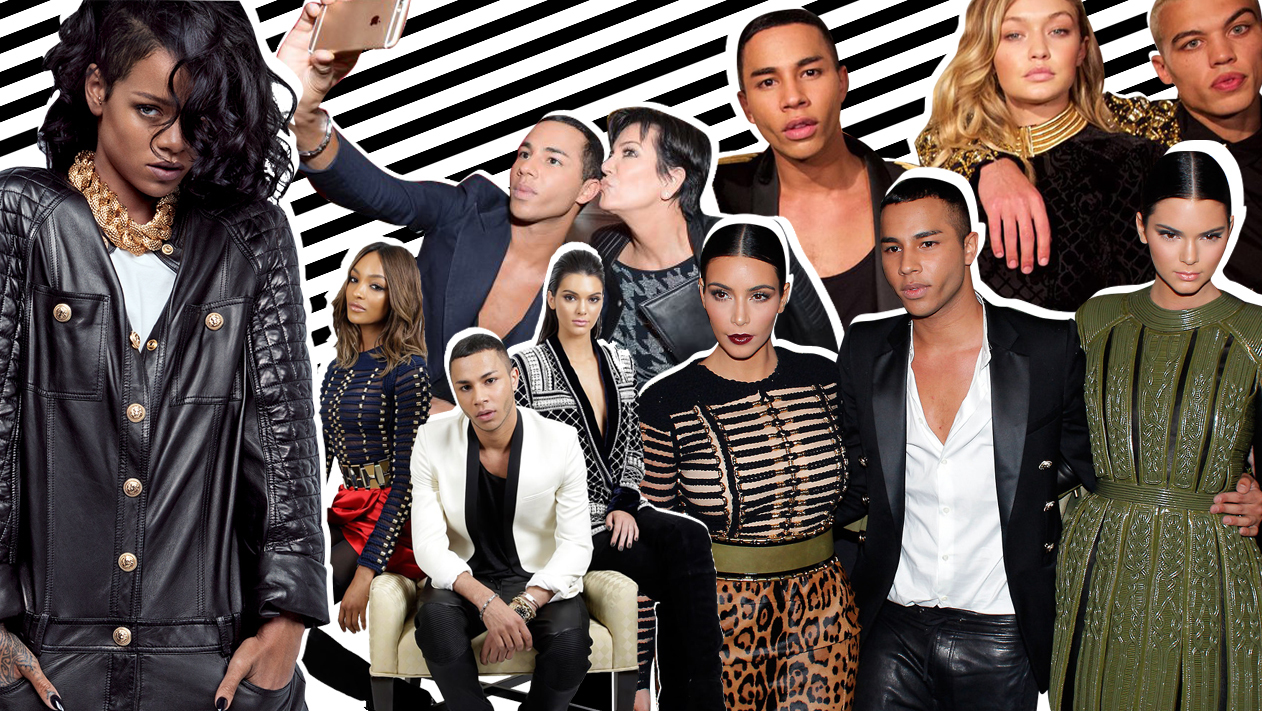The most time-worn monikers to evoke Parisian fashion would have to be “nonchalance” and “effortless” — much of which could as easily be applied to the city’s eternally blasé population. In a nutshell: welcome to Paris, where un soupçon de boredom is the most elegant thing possible.
It doesn’t take more than a few seconds of scrolling down Olivier Rousteing’s Instagram account to realize that Balmain’s creative director is precisely the opposite. He pouts, he poses, he is proud of his achievements, exhilarated to snap a selfie with a celebrity. In other words, he doesn’t pretend he’s not trying — which for the rarified world of French luxe, is perhaps the closest thing to modern-day anarchy.
It is hardly surprising, then, that the same virtues are instilled in Rousteing’s creations: they, too, are unabashedly sexy, bling, over the top, figure hugging — dresses that are clearly delighted to be walked in, down a runway, wrapped around some of the world’s most desired women. Designs that, like their creator, never pretend to be effortless or understated.
That’s probably because Olivier Rousteing’s life has been full of effort. Aged 30, he is the only black designer in Paris — as astounding as it may sound for a city as cosmopolitan as Paris. Raised by adoptive parents, an optician and port worker, in Bordeaux, and frequently harassed in school, he often fantasized about where he might be from: “I dreamed I was the descendent of an Egyptian prince, maybe,” he said in an interview once.
Fashion came to him naturally, it became a powerful, transformative tool “to become whatever you feel you truly are, [fashion] allows you to evolve and change whenever you feel like it.” Rousteing has built his career not through fame or family connections but through really hard, relentless work.
He moved to Italy to work for Peter Dundas at Roberto Cavalli, acquiring the over-the-top elegance executed in the most refined of Italian haute couture. Later he moved on to Balmain, quietly working his way up in the studio; when Olivier Decarnin left Balmain after a rumored nervous breakdown, the then little-known Rousteing was brought out of the shadows and handed the position of creative director.
Little did the house except such a vivid deployment of fame and the famous: after initially pursuing Decarnin’s opulent approach and boxy silhouettes, he moved away from dramatically kitsch pieces on what seemed to be a path of self-discovery.
First off, Rousteing battled to have Rihanna as the face for the brand — wearing richly embroidered denim and leather overalls, a highly provocative move given Balmain’s history.
Slowly but surely, he decided to infuse a more multicultural philosophy and set of references in his clothing: “I realized I had the power to bring into fashion things that had been pushed out. I am different too from this world, I am here now, and I want to broaden the horizon.” His references to African-American culture were broad — ranging from his admiration of Prince and Michael Jackson’s stage costumes, to hip-hop artists and vogueing culture. There he was, a French boy constructing his own vision of global diversified luxury.
Why is this the year of Olivier Rousteing? As one booker once told me: fame isn’t when you hit the pages of Vogue but the pages of tabloids. And this is precisely the stage he is at now: a star who someone from outside the fashion industry might identify with. Case in point: the launch of his collaboration with H&M this fall. Unsurprisingly, he didn’t hesitate to pose in the actual campaign (usually a big no-no in French fashion circles) — proving, if need be, that he is one of the last few designers to be identifiable for the public at large.
And the launch itself? 16 hours before the doors of the H&M boutique on the Champs Elysées were due to open, people were already waiting in line, some even with tents, ready to spend the night. Most were hoping to catch a selfie with the designer, widely expected to attend the opening and greet the fans. In other words, Rousteing has reached a level of recognition closer to a pop star than that of your average fashion designer. As for the collection, it worked out nicely: within hours, bottles of water with the Balmain label that had been handed out to people waiting in line were being sold for hundreds of euros online – and so were the paper bags and clothes hangers.
Being a French woman myself, it’s not hard to see why he appeals to so many: Rousteing looks to women everywhere, not just parisiennes (bored or not); anyone who feels like an outcast from local fashion and beauty standards (think stick-thin, pared down, shabby hair) will find something more comforting in his approach and his idols. Just take Kim Kardashian, who has been one of his most recurring muses, alongside her sisters Kylie and Kendall Jenner: she is precisely what the French (and fashion at-large) turn their noses up at. She is neither skinny nor trying to be; her style is at odds with required notions of discretion, refinement, minimalism. Her career is based on fluff and her makeup is crêpe-thick. Yet Rousteing sees her as a modern success story. “In her own way she has succeeded and gone to the top; she is a modern amazon.”
And this story of social progression, from the last pages of the tabloids to the front row at fashion weeks, is one that clearly resonates with the French: it celebrates the deeply performative power of style, where you are what you present yourself as, bringing hope to everyone outside those limiting boundaries of personal wealth, title, origin.
Credits
Text Marguerite Taras
